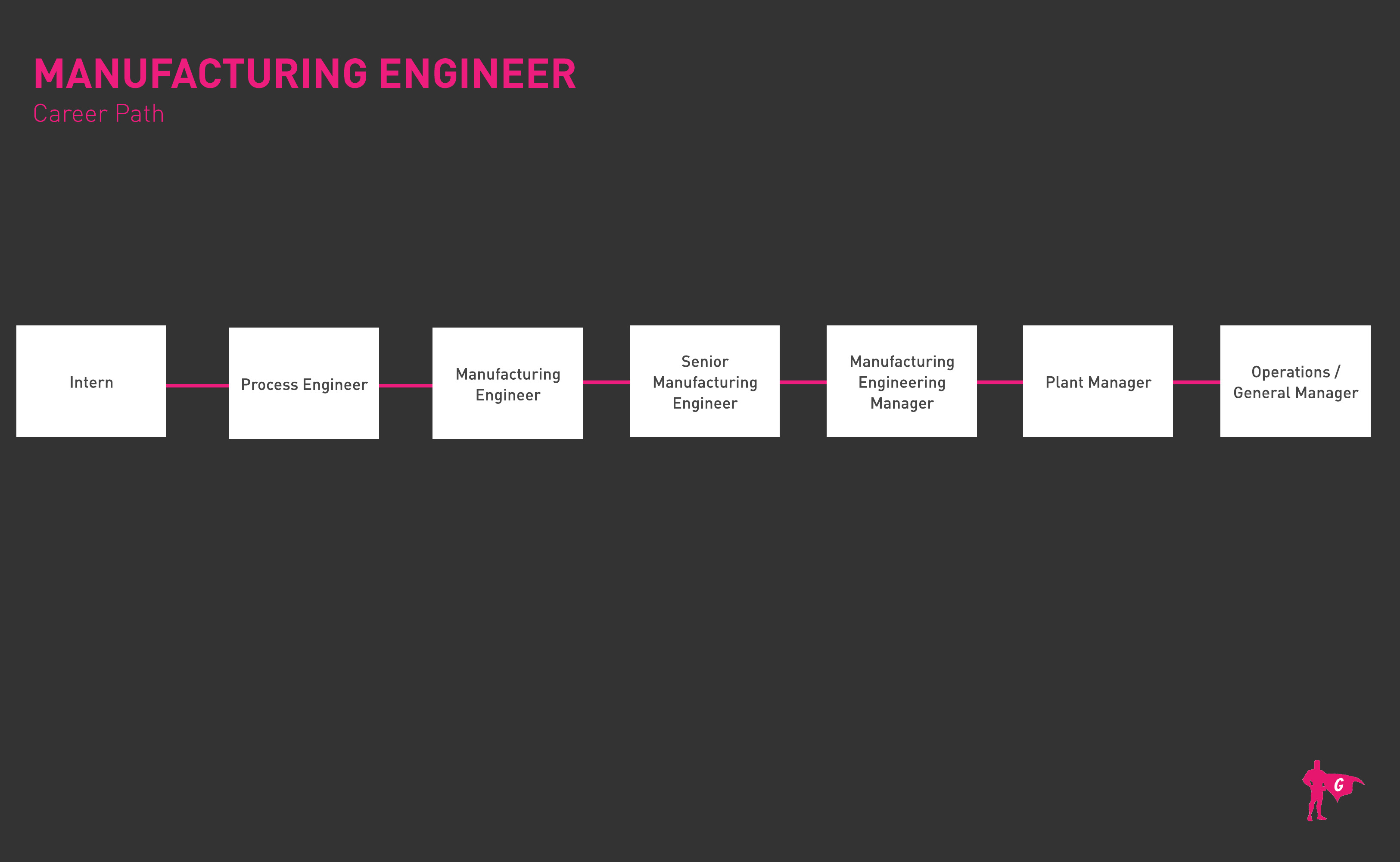Spotlights
Facility Engineer, Manufacturing Engineer, Plant Engineer, Process Engineer, Process Improvement Engineer
If a product isn’t handmade, chances are it was manufactured in a factory somewhere. Manufacturing goods is a highly complex yet well-organized process that involves several workers. Among the most critical factory employees are Manufacturing Engineers. These are the versatile experts who ensure production lines run smoothly and safely so products can be made as cost-efficiently as possible.
They might be in charge of a wide range of manufacturing systems such as “computer networks, robots, machine tools, and materials-handling equipment.” Workplace safety is of major concern to Manufacturing Engineers as they look for ways to cut out wasteful aspects of production processes, taking into account how many workers are needed for a task, what steps they’ll perform, which technologies they’ll need, and how much it all costs. They may oversee quality assurance processes to ensure products meet specifications and are ready to ship out to stores or warehouses to await purchase.
- Collaborating with commercial and industrial designers to improve products
- Working with various teams toward a common goal
- Helping to keep employees safe from workplace hazards
- Maximizing production efficiency to keep employers’ costs down
- Developing exciting new concepts and products to market to consumers
- Turning ideas into tangible goods
- Improving technologies able to perform dangerous tasks so people won’t have to
Lịch làm việc
- Most Manufacturing Engineers work full-time, with overtime possible during busy seasons, or when production is behind schedule or orders exceed projections.
- Nhiệm vụ tiêu biểu
- Meet with customers to discuss specifications for their desired products
- Talk to vendors and management regarding the status of capabilities, timetables, limitations, and possible solutions to issues
- Determine the right tools, machines, equipment, and processes to manufacturer specific parts or products based on specifications
- Seek ways to decrease or eliminate harmful practices and materials
- Review schedules and workflows to ensure the correct number of workers are assigned
- Use management control systems to organize team efforts
- Establish quality assurance protocols to ensure products are made to standards
- Continually assess production speed and look for ways to improve efficiency and reduce costs using lean manufacturing principles
- Collaborate with production teams to keep things on time, on target (and on-budget)
- Analyze workflows to search for (and mitigate) potential problems such as bottlenecks
- Create backup plans to work around unforeseen problems that could cause delays or work stoppages
- Test and troubleshoot designs, materials, and processes
- Offer technical assistance or training as needed
- Check-in regularly with staff to see how projects are progressing. Supervise, as needed
- Investigate the root causes of production failures and suggest fixes or adjustments
- Generate reports on manufacturing performance
- Review financial factors related to sustainable processes and offer suggestions to management
- Ensure timely delivery of goods to clients while maintaining cost-effective transportation practices
Trách nhiệm bổ sung
- Design workspace and equipment layouts and oversee installations
- Procure equipment, parts, and various materials, as needed
- Write documentation for various work processes
- Stay up-to-date on fabrication and assembly process improvements
- Read about trends and technological advances in tooling and equipment and incorporate them when feasible
- Đảm bảo tuân thủ các quy tắc và tiêu chuẩn của tiểu bang, liên bang và quốc tế
- Participate in continuing education and professional organization events
Kỹ năng mềm
- Khả năng khái niệm hóa
- Khả năng tạo điều kiện cộng tác giữa các nhóm
- Phong cách thích ứng
- Phân tích
- Ý thức về ngân sách
- Bình tĩnh dưới áp lực
- Định hướng tuân thủ và an toàn
- Tập trung và tập trung
- Kỹ năng quản lý hồ sơ tốt
- Sáng kiến
- Đổi mới
- Điều tra
- Lãnh đạo
- Tổ chức
- Kiên nhẫn
- Giải quyết vấn đề
- Thực tế
- Con người mạnh mẽ và kỹ năng giao tiếp
- Làm việc theo nhóm
- Time-management
Kỹ năng kỹ thuật
- Computer-aided design (CAD) tools such as Autodesk AutoCAD
- Knowledge of assembly line processes
- Knowledge of Solidworks
- Lean manufacturing
- Process improvement
- Quality assurance principles
- Root cause analysis
- Six Sigma
- Troubleshooting tactics
- Understanding of mechanical engineering
- Automotive industry; transportation equipment manufacturing
- Computer/electronic products makers
- Công ty sản xuất
- Các cơ quan quân sự và chính phủ
Manufacturing Engineers keep factory production running smoothly, but there’s a ton of work and planning to get to that point. From choosing laborers with the right skills and selecting the best tools, equipment, and machinery to laying out workspaces and establishing procedures, Manufacturing Engineers certainly have their work cut out for them!
Companies rely heavily on their talents to keep production flowing, costs down, and workers safe. One bad decision or oversight can throw a proverbial monkey wrench in the works, causing expensive manufacturing problems ranging from defective products to safety recalls and total work stoppages. If a seriously unsafe product hits the market, it can tank a company’s reputation and spell financial ruin for its future. Other times, a product probably should’ve been nixed during the concept phase, such as Cheetos’ disastrous lip balm product fail.
The job outlook is strong for Manufacturing Engineers, in part because of the cost savings they bring to the table. A major part of the job is staying on top of trends and innovations, of which there are several these days.
Automation has long been a key goal of many factories and is becoming increasingly prevalent and easier to use. Mobile and collaborative robots are also primed to alter the manufacturing landscape, bringing exciting new capabilities to bear. Meanwhile, the fabled Internet of Things keeps chugging along, empowering companies to gather valuable data they can use to optimize processes.
Hailed as the Fourth Industrial Revolution, Industry 4.0 is living up to the hype with several initiatives driven by “high-speed mobile Internet, AI and automation, the use of big data analytics, and cloud technology.” Additional trends include the spreading use of Enterprise Resource Planning, which is hardly new but is simpler to deploy now thanks to cloud-based SaaS.
Manufacturing Engineers are very methodical and process-oriented. They may have enjoyed doing meticulous activities that required following lots of steps in a precise order, such as building intricate LEGO sets. They’re keen on cutting out inefficiencies, and might have found ways to get their chores (or their homework) done faster than others might take. As with most engineers, they usually love figuring out how to turn abstract ideas into concrete realities through a bit of creative thinking and tinkering.
Because they are often immersed in cutting-edge technology including AI and robotics, they might have been avid science fiction fans as kids. And since they must oversee the work of many people and groups, Manufacturing Engineers generally have well-developed soft skills that were likely cultivated in school extracurricular activities or simply from growing up in a large family.
- 70% of Manufacturing Engineers hold a bachelor's degree; 16% hold a master's. Many university programs feature dual bachelor’s/master’s degree tracks which take ~5 years
- Most major in industrial engineering, manufacturing engineering, or mechanical engineering
- Engineering programs should be accredited by ABET
- Một thạc sĩ thường là cần thiết để giảng dạy hoặc làm việc trong R &D
- Thực tập, hợp tác và các kinh nghiệm làm việc thực tế khác được các nhà tuyển dụng trân trọng
- A license isn’t needed to get started, but Professional Engineering (PE) licensure can lead to promotion opportunities
- Pe phải vượt qua hai kỳ thi:
- Nguyên tắc cơ bản của kỹ thuật (FE)
- Kỳ thi Nguyên tắc và Thực hành Kỹ thuật (PE)
- Pe phải vượt qua hai kỳ thi:
- There are several optional certifications to consider, including:
- American Society for Quality - Certified Six Sigma Yellow Belt
- Hiệp hội Kỹ sư Cơ khí Quốc tế Hoa Kỳ - Geometric Dimensioning & Tolerancing Professional - Technologist
- Autodesk -
- Autodesk Moldflow Insight Professional Certification
- Autodesk Moldflow Insight Associate Certification
- International Association of Six Sigma Certification - various colored belts
- Packaging Machinery Manufacturing Institute - Mechatronics Certification Test - Motor and Motor Controls
- SAP America- Certified Application Associate - SAP S/4HANA Cloud (public) - Manufacturing Implementation
- Society for Maintenance & Reliability Professionals - Certified Maintenance & Reliability
- Society for Manufacturing Engineers -
- Lean Silver Certification
- Six Sigma Green Belt Certification
- Certified Manufacturing Engineer
- Chứng nhận đai đen Six Sigma Master
- Chứng nhận Lean Gold
- Các chương trình phải được ABET công nhận, đây là yêu cầu đối với giấy phép PE sau này
- Look for scholarships and STEM pathways to save time and money
- Consider the program’s faculty awards and accomplishments. Prestigious honors include: teaching awards, IEEE and National Science Foundation awards and recognitions, Fulbright Fellowships, best papers, and distinguished lecturers
- Check out their facilities (especially if you’re planning to attend in person). Well-funded programs will have the most modern, cutting-edge research areas
- Tìm kiếm các trung tâm và viện liên kết. Hầu hết các chương trình lớn cộng tác với các đối tác bên ngoài có thể tăng cường đáng kể trải nghiệm học tập của bạn
- Always see what benefits or resources schools offer their graduates. Do they help with interview prep or have close ties with local industry? Does the alumni network offer career-enhancing mentorship and networking?
- It pays to get a jump start on college by taking prep classes in high school, such as math, physics, engineering, and technology. Strong English and technical writing skills will also pay off later
- Decide what type of manufacturing you want to get involved with, such as automotive, commercial products, computers, etc.
- Learn everything you can about the career field before signing up for classes. Do some early reconnaissance by reading job descriptions posted on employment portals
- Make a list of organizations you dream of working for, and maybe reach out to current employees to pick their brains
- Major manufacturing companies based in the US include Ford, General Motors, Dell, Johnson & Johnson, General Electric, Intel, IBM, Procter & Gamble, PepsiCo, Lockheed Martin, Boeing, Hewlett-Packard, and Raytheon
- Get practical experience through internships or apprenticeships
- Đừng bỏ bê các kỹ năng mềm. Các kỹ sư cũng nên là "con người"!
- Tình nguyện phục vụ trong các ủy ban của trường hoặc giúp đỡ các hoạt động ngoại khóa, tập trung vào các vai trò cung cấp kinh nghiệm lãnh đạo và quản lý
- Comb through our below list of Recommended Websites to find professional groups to join
- Be an active participant in your school's engineering clubs
- Ask a seasoned Manufacturing Engineer if they will do an informational interview with you

- College grads will need to apply to entry-level Manufacturing Engineer positions in factories or warehouses
- Having a year or two of relevant work experience will help make you more competitive when applying
- Internships may be great opportunities to snag practical experience, plus they sometimes lead to full-time jobs!
- Be flexible about the hours you can work. New hires may be tagged for night or weekend duty
- Đăng ký nhận thông báo trên các cổng thông tin việc làm như Indeed, SimplyHired, Monster, USAJobs, ZipRecruiter, LinkedIn, Velvet Jobs và Glassdoor
- Ask everyone in your network about openings. Per PayScale, 85% of jobs are found through networking!
- Ask your school’s career center for help with resume writing, mock interviewing, and connecting with recruiters
- Do your homework on the company and tailor your resume to the specific job posting, every time
- Review Manufacturing Engineer resume templates and common interview questions
- Keep in mind that smaller companies may never have the advancement opportunities you might want later, but they are probably more likely to hire someone with less experience
- Become a subject matter expert who gets things done, smooths processes, cuts costs, and keeps workers productive and safe
- Map out your long-term goals, establish milestones, and strategize how you’ll achieve them
- When you have enough work experience, knock out a professional certification
- Get your Professional Engineer license to show your commitment to excellence and desire to tackle bigger responsibilities
- Have frank conversations with your employer to discuss your career goals. Ask about promotion opportunities when the time is right, and be mindful of the time and effort they’ve invested in you
- Try to stay flexible without compromising your dreams. If an in-house promotion is possible in the near future, it might be better to wait rather than jump ship to work for another company
- Decide what’s more important to you — a higher pay rate or a more personally rewarding job? If you can find both, that’s even better!
- If you work for a smaller company, your options may be permanently limited unless you apply elsewhere, but if you can’t get a promotion then at least ask for a raise and justify your reasons
Các trang web
- Hội đồng công nhận kỹ thuật và công nghệ
- Hiệp hội Giáo dục Kỹ thuật Hoa Kỳ
- Hiệp hội Kỹ sư Cơ khí Hoa Kỳ
- Engineering Education Service Center
- Institute of Industrial & Systems Engineers
- Hội đồng Giám khảo Quốc gia về Kỹ thuật và Khảo sát
- Hiệp hội kỹ sư chuyên nghiệp quốc gia
- Hiệp hội kỹ sư sản xuất
- Hiệp hội kỹ sư nữ
- Hiệp hội sinh viên công nghệ
Sách vở
- Fundamentals of Modern Manufacturing: Materials, Processes and Systems, by Mikell P. Groover
- Manufacturing Engineering & Technology, by Serope Kalpakjian and Steven Schmid
- Manufacturing Engineering Handbook, by Hwaiyu Geng
There are several fields and subfields of engineering, and hundreds of career paths to choose from. If Manufacturing Engineering doesn’t sound like your cup of tea, a few alternative engineering-related jobs include:
- Kỹ sư hàng không vũ trụ
- Quản lý kiến trúc và kỹ thuật
- Kỹ sư y sinh
- Kỹ sư phần cứng máy tính
- Kỹ thuật viên kỹ thuật điện và điện tử
- Kỹ sư hậu cần
- Kỹ sư cơ khí
- Quản trị viên Hệ thống Mạng và Máy tính
- Kỹ sư quang tử
- Kỹ sư bán hàng
For those who don’t necessarily want to pursue an engineering path, occupations that are also related to Manufacturing Engineering include:
- Công cụ ước tính chi phí
- Giám đốc sản xuất công nghiệp
- Nhà logistic
- Nhà phân tích quản lý
- Chuyên gia và kỹ thuật viên an toàn và sức khỏe nghề nghiệp
- Thanh tra kiểm soát chất lượng
Nguồn cấp tin tức

Công việc nổi bật

Các khóa học và công cụ trực tuyến

Kỳ vọng về mức lương hàng năm
Người lao động mới bắt đầu với mức lương khoảng 80.000 đô la. Mức lương trung bình là 101.000 đô la mỗi năm. Người lao động có nhiều kinh nghiệm có thể kiếm được khoảng 132.000 đô la.
Kỳ vọng về mức lương hàng năm
New workers start around $108K. Median pay is $164K per year. Highly experienced workers can earn around $211K.
Kỳ vọng về mức lương hàng năm
New workers start around $85K. Median pay is $111K per year. Highly experienced workers can earn around $146K.
Kỳ vọng về mức lương hàng năm
New workers start around $82K. Median pay is $111K per year. Highly experienced workers can earn around $143K.
Kỳ vọng về mức lương hàng năm
New workers start around $75K. Median pay is $98K per year. Highly experienced workers can earn around $133K.






